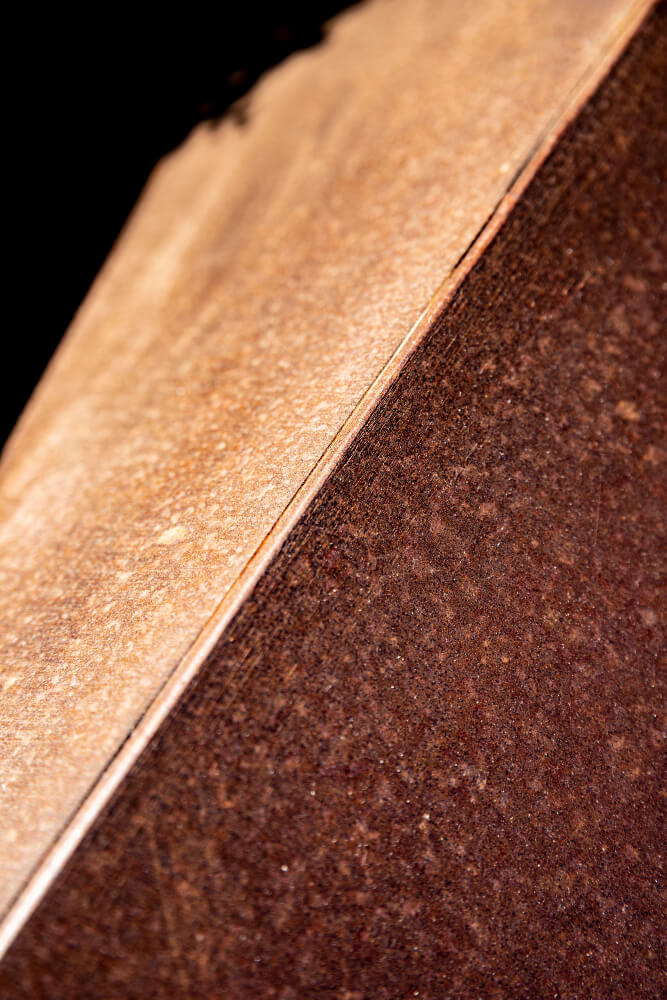Why Is My Faux Leather Peeling? (It’s Not Just Wear and Tear)
Let’s be real: finding that first patch of peeling on your favorite chair or bag is a major letdown. But before you get frustrated with the item itself, it helps to know that this is a common material issue, not a sign that you’ve done something wrong.
Think of faux leather as a sandwich. The top slice of bread is a thin, colored plastic layer (called polyurethane or PU) that gives it the smooth, leather-like look. The bottom slice is a soft fabric backing. The “flaking” happens when the glue between the bread slices fails, and the top layer starts to crack and peel away.
This is the natural life cycle of materials like bonded leather, which is especially prone to this. So, when you see flaking faux leather, you’re simply witnessing its built-in expiration date. The good news? You can absolutely glue that sandwich back together.
The 5 Culprits Accelerating the Damage
While some peeling is inevitable over time, a few things speed up the process dramatically. Knowing these enemies can help you protect your next item!
The Sun: Just like a car dashboard left in a hot parking lot, direct sunlight bakes and brittles the plastic coating, making it crack faster.
Constant Rubbing: That spot on the driver’s seat you always slide into, or the armrest you lean on friction slowly sands the coating away.
Harsh Cleaners: Spraying strong chemicals like bleach or ammonia-based cleaners can break down the material, causing premature cracking and flaking.
Dampness: Spills that aren’t wiped up or a humid room can weaken the bond between the layers from the inside out.
It Was Just Made That Way: Let’s be honest some cheaper items are made with a super-thin coating that’s just not built to last.
Understanding these culprits isn’t about placing blame; it’s about empowering you to make your next repair last longer. Now, let’s clear up the confusing name game.
The Solution Matrix (The “How”)
Your Repair Toolkit: Matching the Method to Your Damage & Budget
Okay, so your item is fixable. Now, how do you choose the right method? Don’t worry, it’s easier than it looks. The best way to fix peeling faux leather depends on what you’re fixing and the look you want.
Think of it like this:
Repair Kits are your go-to for a seamless, professional finish on furniture.
Liquid Rubber is the tough guy, perfect for car seats or items that need a textured, super-durable coat.
Fabric Paint is the artist’s choice for matching unique colors perfectly.
The Quick Fix is your first-aid kit for stopping a small problem from becoming a big one.
You don’t need to be a pro for any of these. It’s all about picking the right tool for the job. Let’s break down each method so you can confidently choose your path to a successful faux leather repair.
The Repair Methods in Action
Method 1: The Professional’s Choice (Using a Repair Kit)
For a bonded leather repair that looks invisible, a dedicated kit is your best bet. These kits, like the popular Rub ‘n Restore, contain a liquid vinyl that actually bonds with your existing material.
The process is simple:
- Clean & Peel: Thoroughly clean the area and gently remove all loose flakes.
- Apply & Spread: Use the provided spreader to apply the compound, feathering the edges to blend it in.
- Match the Texture: Press the graining paper onto the wet compound to recreate the leather-like grain.
- Let it Cure: Walk away and let it dry completely. The result is a flexible, durable patch that looks and feels like the original.
Method 2: The Tough & Textured Fix (Using Liquid Rubber)
Wondering if Flex Seal works on faux leather? For a car interior, boots, or a workbench stool, it’s a fantastic and affordable diy faux leather repair.
Here’s the trick:
- Prep Well: Clean the area meticulously and remove every loose flake.
- Spray Thin Coats: Apply multiple very thin coats from a spray can, or brush it on. Thick coats will run and look messy.
- Be Patient: Let each coat get tacky before applying the next.
- Embrace the Texture: It will dry with a slightly rubberized, textured finish that is incredibly tough and long-lasting.
More Ways to Fix and Save Your Item
Method 3: The Perfect Color Match (Using Fabric Paint)
If you have a uniquely colored couch or bag, fabric paint is your secret weapon for restoring faux leather.
The steps are straightforward:
Clean the Surface: Start with a perfectly clean and dry surface.
Paint: Use a soft sponge to dab on high-quality, flexible fabric paint. Build up the color with thin layers until it matches perfectly.
Seal the Deal: This is the most important step! Once the paint is dry, you must apply a flexible acrylic sealer. This top coat protects your beautiful paint job from scratches and wear, making the repair last.
Method 4: The “Stop It Now!” Quick Fix
See a small edge just starting to lift? You can stop it in its tracks with a simple fix for peeling faux leather.
All you need is a clear-drying, flexible glue like Mod Podge.
- Gently lift the loose edge.
- Use a toothpick to slide a tiny amount of glue underneath.
- Press it down firmly, wipe away any excess, and place a heavy book on top until it’s completely dry.
It’s a simple trick that can prevent a much bigger repair job later.
Your Guide to a Flawless Repair
The Golden Rules of Faux Leather Repair
Before you start, remember these four simple rules. They are the difference between an “okay” fix and a great one!
- Cleanliness is Key: Any dirt or skin oils will prevent the repair product from sticking. Give the area a final wipe with isopropyl alcohol for a perfect surface.
- Always Test First: Before you slather product everywhere, do a small patch test in a hidden spot (like the back or an underside). This ensures you’re happy with the color and finish.
- Patience is Everything: Rushing the drying time is the most common mistake. If the instructions say wait 2 hours, wait 2 hours. Let each layer dry fully.
- Breathe Easy: Work in a well-ventilated area. Open a window to keep the air fresh while you work.
Keeping Your Faux Leather Looking New
Beyond the Fix: How to Make Your Faux Leather Last
You’ve put in the work to fix it now let’s make sure it stays that way! Protecting your faux leather from peeling again is all about simple, consistent care.
Your Easy Care Routine:
- Weekly: Give it a quick wipe with a damp cloth to remove dust and dirt.
- Monthly: Do a deeper clean with a mild soap and water solution. Once it’s clean and dry, use a dedicated faux leather conditioner to keep the material soft and prevent it from drying out and cracking.
- Always: Try to keep furniture out of direct sunlight and be mindful of sharp objects like pet claws or belt buckles.
A little bit of love goes a long way in keeping your restored item looking beautiful for years to come.


